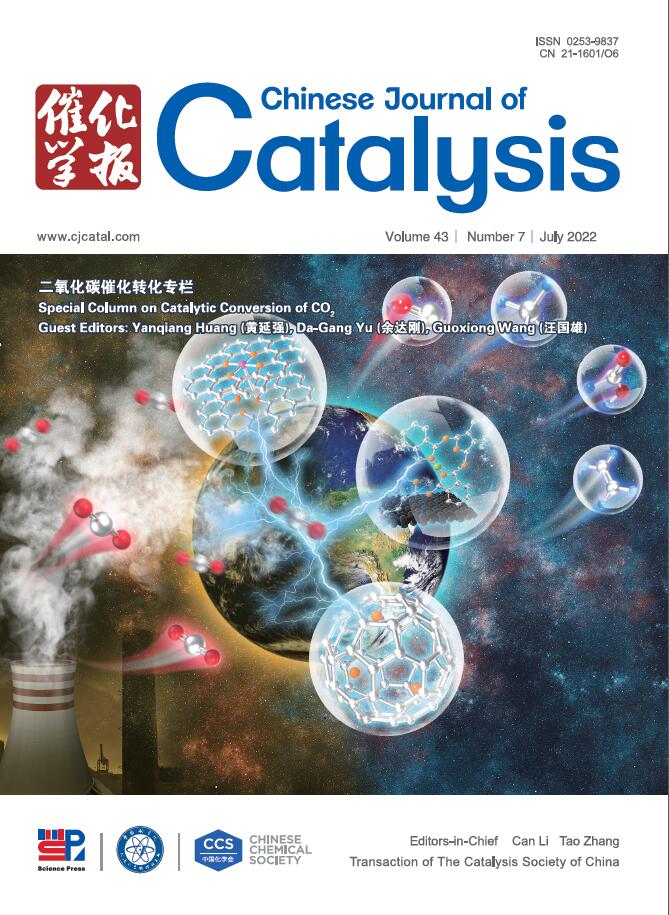Microenvironment engineering of nitrogen-doped hollow carbon spheres encapsulated with Pd catalysts for highly selective hydrodeoxygenation of biomass-derived vanillin in water
IF 15.7
1区 化学
Q1 CHEMISTRY, APPLIED
引用次数: 0
Abstract
Development of efficient and stable metal catalysts for the selective aqueous phase hydrodeoxygenation (HDO) of biomass-derived oxygenates to value-added biofuels is highly desired. An innovative surface microenvironment modulation strategy was used to construct the nitrogen-doped hollow carbon sphere encapsulated with Pd (Pd@NHCS-X, X: 600–800) nanoreactors for catalytic HDO of biomass-derived vanillin in water. The specific surface microenvironments of Pd@NHCS catalysts including the electronic property of active Pd centers and the surface wettability and porous structure of NHCS supports could be well-controlled by the calcination temperature of catalysts. Intrinsic kinetic evaluations demonstrated that the Pd@NHCS-600 catalyst presented a high turnover frequency of 337.77 h–1 and a low apparent activation energy of 18.63 kJ/mol. The excellent catalytic HDO performance was attributed to the unique surface microenvironment of Pd@NHCS catalyst based on structure-performance relationship analysis and DFT calculations. It revealed that pyridinic N species dominated the electronic property regulation of Pd sites through electronic metal-support interaction (EMSI) and produced numerous electron-rich active Pd centers, which not only intensified the dissociation and activation of H2 molecules, but also substantially improved the activation capability of vanillin via the enhanced adsorption of –C=O group. The fine hydrophilicity and abundant porous structure promoted the uniform dispersion of catalyst and ensured the effective access of reactants to catalytic active centers in water. Additionally, the Pd@NHCS-600 catalyst exhibited excellent catalytic stability and broad substrate applicability for the selective aqueous phase HDO of various biomass-derived carbonyl compounds. The proposed surface microenvironment modulation strategy will provide a new consideration for the rational design of high- performance nitrogen-doped carbon-supported metal catalysts for catalytic biomass transformation.
包覆Pd催化剂的氮掺杂空心碳球在水中高选择性加氢脱氧生物质香兰素的微环境工程
开发高效、稳定的金属催化剂用于生物质衍生的含氧化合物的选择性水相加氢脱氧(HDO)以生产增值生物燃料是迫切需要的。采用一种创新的表面微环境调制策略,构建了包覆Pd (Pd@NHCS-X, X: 600-800)的氮掺杂空心碳球纳米反应器,用于催化生物质香兰素在水中的HDO反应。催化剂的煅烧温度可以很好地控制Pd@NHCS催化剂的特定表面微环境,包括活性钯中心的电子性质、NHCS载体的表面润湿性和多孔结构。内禀动力学评价表明,Pd@NHCS-600催化剂具有较高的周转频率(337.77 h-1)和较低的表观活化能(18.63 kJ/mol)。基于结构-性能关系分析和DFT计算,认为Pd@NHCS催化剂具有独特的表面微环境,具有优异的HDO催化性能。结果表明,吡啶类N通过电子金属-载体相互作用(EMSI)主导了Pd位的电子性质调控,产生了大量富电子的活性Pd中心,不仅加剧了H2分子的解离和活化,而且通过增强对c =O基团的吸附,大大提高了香兰素的活化能力。良好的亲水性和丰富的多孔结构促进了催化剂的均匀分散,保证了反应物在水中有效接近催化活性中心。此外,Pd@NHCS-600催化剂对各种生物质衍生羰基化合物的选择性水相HDO表现出优异的催化稳定性和广泛的底物适用性。所提出的表面微环境调节策略将为合理设计高性能的氮掺杂碳负载金属催化生物质转化催化剂提供新的思路。
本文章由计算机程序翻译,如有差异,请以英文原文为准。
求助全文
约1分钟内获得全文
求助全文
来源期刊

Chinese Journal of Catalysis
工程技术-工程:化工
CiteScore
25.80
自引率
10.30%
发文量
235
审稿时长
1.2 months
期刊介绍:
The journal covers a broad scope, encompassing new trends in catalysis for applications in energy production, environmental protection, and the preparation of materials, petroleum chemicals, and fine chemicals. It explores the scientific foundation for preparing and activating catalysts of commercial interest, emphasizing representative models.The focus includes spectroscopic methods for structural characterization, especially in situ techniques, as well as new theoretical methods with practical impact in catalysis and catalytic reactions.The journal delves into the relationship between homogeneous and heterogeneous catalysis and includes theoretical studies on the structure and reactivity of catalysts.Additionally, contributions on photocatalysis, biocatalysis, surface science, and catalysis-related chemical kinetics are welcomed.
 求助内容:
求助内容: 应助结果提醒方式:
应助结果提醒方式:


